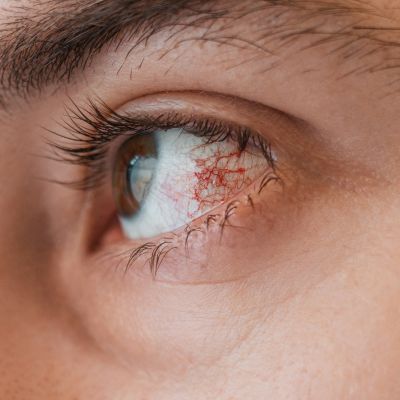Pink eye is an infection of the thin layer of tissue covering the white part of the eye and lining the inner eyelid. Also known as conjunctivitis, it’s most common in children and highly contagious. Fortunately, it’s unlikely to affect your vision. The most common symptom is reddened eyes, but not all reddened eyes are due to the condition.
Other eye conditions that it can be mistaken for include:
- Allergies
- Styes
- Iritis
- Keratitis
- Blepharitis
Contact our office if you’re experiencing symptoms like the condition. Our expert optometrists can perform an exam to identify the cause. Once determined, they can prescribe treatment to help your eyes feel healthy again.
What Is Commonly Misdiagnosed as Pink Eye?
1. Allergies
Pink eye is usually an infection or inflammation of tissue underneath the eyelids. This tissue is known as the conjunctiva, which is why it’s also referred to as conjunctivitis. However, “pink eye” is sometimes used as a catch-all for when people experience similar symptoms, including those of allergies.
Common symptoms shared by conjunctiva and allergies include eyes that are:
- Itchy
- Watery
- Burning
- Pink or red
It’s also common to wake up in the morning with discharge that has built up around your eyes.
Pink eye is an infection of the thin layer of tissue covering the white part of the eye and lining the inner eyelid. Also known as conjunctivitis, it’s most common in children and highly contagious. Fortunately, it’s unlikely to affect your vision. The most common symptom is reddened eyes, but not all reddened eyes are due to pink eye.
Other eye conditions can be mistaken for pink eye, including:
- Allergies
- Styes
- Iritis

- Keratitis
- Blepharitis
Contact our office if you’re experiencing symptoms similar to pink eye. Our expert optometrists can perform an exam to tell if it’s pink eye or not and prescribe treatment to help your eyes feel healthy again.
Conjunctivitis comes in three forms — viral, allergic, and bacterial. They don’t simply share a lot of the same symptoms. They also share many of the same symptoms as allergies (allergic conjunctivitis). Telling the difference between viral or bacterial conjunctiva and allergies can be difficult. One of the best ways is to assess your allergy triggers.
For example, you may experience symptoms:
- During spring when there’s more pollen in the air
- After dusting
- After brushing your pet
In these cases, using OTC antihistamines should be enough to treat your allergies.
Click here to learn the difference between allergies, eye infections, and dry eye syndrome!
2. Styes
Styes (hordeolum) can be confused with conjunctivitis due to having:
- Itchiness
- Redness
- Inflammation
A subtle key difference is the kind of discharge they produce. Discharge from a stye can be crusty. Discharge from conjunctivitis tends to be more sticky. Styes also tend to be more tender and are accompanied by droopy eyelids.
The main difference is the small bump on the eyelid or eyelash that usually accompanies a stye. This pimple-like bump is the result of bacteria causing the infection or inflammation. A bump at the base of an eyelash is known as an external hordeolum. One inside the eyelid’s oil gland is known as an internal hordeolum.
Styes can sometimes be treated at home. Avoid wearing eye makeup for a few days if you ever wear any. Apply warm compresses to the affected area and take pain relievers if it hurts. Never pop a stye. Contact us immediately if the stye doesn’t begin to recede or if it begins to affect your vision.
3. Iritis
Iritis (anterior uveitis) is when your iris becomes inflamed. It affects the middle layer of your eye (the uvea) between the white part and the retina. Iritis is the most common type of uveitis, but its cause in most cases is unknown. It may show that you may have an autoimmune disorder or inflammation across your body. See your eye doctor immediately if you have iritis since it can lead to serious vision problems.
Iritis can be mistaken for pink eye due to both involving:
- Redding of the eye
- Pain or discomfort
- Sensitivity to light
- Diminished vision
The difference between iritis and conjunctivitis is the inflamed part of the eye. Iritis affects the inside of your eye, but conjunctivitis affects the outer layer. Contact our office and schedule a comprehensive eye exam. if you’re having symptoms. We can determine which you have and provide the treatment that you need.
4. Keratitis

The inflammation of the cornea is known as keratitis. Like conjunctivitis, it results in eyes that are red and irritated. However, conjunctivitis is more common than keratitis, affecting millions more people a year. But keratitis is more dangerous, possibly leading to decreased vision or blindness.
Some symptoms of keratitis are like the condition. On the other hand, they also tend to be more severe. Patients report more pain with keratitis, along with blurred and reduced vision.
Keratitis is usually caused by contacts that haven’t been cared for properly. This could be due to not cleaning them properly, if at all, and wearing them while you sleep. It’s important to care for your contacts properly. One way to do this is by using daily contact lenses. They ensure you use a fresh pair daily, protecting your eyes from keratitis.
Want to learn more about the benefits of daily contact lenses? Click here to find out!
5. Blepharitis
Blepharitis is commonly misdiagnosed as pink eye. It can have similar symptoms, such as:
- Swelling of the conjunctiva
- Watery eyes
- Eyes feeling itchy or irritated
- Crusty eyelids and lashes
The difference between the two is which part of the eye is affected. Blepharitis involves the inflammation of the eyelids, while conjunctivitis affects the conjunctiva.
The key to treating blepharitis is hygiene. In many cases, washing your eyelids and using warm compresses is usually enough. However, medication may be prescribed if the infection doesn’t go away. Underlying issues may need to be treated, such as dermatitis or rosacea. In extreme cases, blepharitis can be treated with a surgical procedure.
Are you suffering from irritated eyes but don’t know what’s causing them? Contact us today to schedule your appointment!
There are eye conditions with similar symptoms to pink eye. It’s common to mistake allergies, styes, iritis, keratitis, and blepharitis for it. They can have different causes and require different treatments. Protect your eye health by setting up an exam with our team. We can identify what’s causing your symptoms and provide treatment.
Hardin Valley Eyecare & Optical has been serving Knoxville since 2009. Located at 10904 Spring Bluff Way, you can schedule an appointment online or call us at (865) 888-0892.
*This blog was last updated in November of 2023. It has been updated for clarity and new information.






